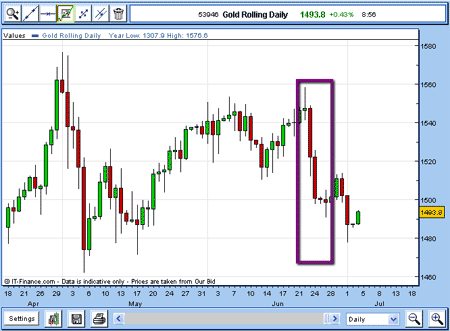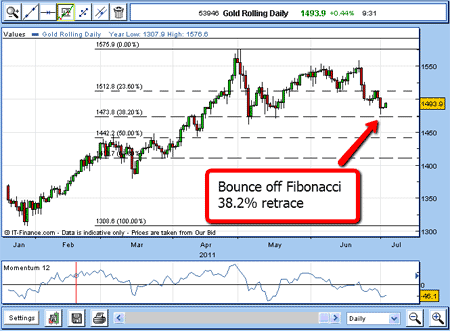What's next for gold?
With recent falls in the price of gold, some traders are shifting their positions, cashing out of long trades and increasing their short trades. But overall sentiment is still bullish. So where might gold be going next? John C Burford looks to the charts for answers.
As I write on 4 July US fireworks day (real pyrotechnics, but not necessarily in the markets), I have noted a significant shift in investor positioning in the gold futures market.
Remember, the Comex gold contract of 100 oz drives the gold pricing mechanism, including the cash quotes. That makes the commitments of traders(COT) reports a crucial piece of information for traders.
In my previous emails, I have alluded to the COT reports as describing the severely unbalanced nature of the gold market (less so in silver).
MoneyWeek
Subscribe to MoneyWeek today and get your first six magazine issues absolutely FREE

Sign up to Money Morning
Don't miss the latest investment and personal finances news, market analysis, plus money-saving tips with our free twice-daily newsletter
Don't miss the latest investment and personal finances news, market analysis, plus money-saving tips with our free twice-daily newsletter
There has been intense investor buying from both the large traders (hedge funds, especially) and the small trader.
I pointed out that this measure of extreme sentiment would inevitably lead to at least a decent price fall.
And I didn't have to wait long after my last gold email for this to occur!
Gold has seen a hefty fall
We have seen a $50 move down to the $1,480 low on Friday:

(Click on the chart for a larger version)
As I write, we are seeing an inevitable relief rally from an oversold position.
This down move was pretty much unexpected by the gold aficionados (but then, they always are). How has the COT position changed in this move?
To cut a short story even shorter there has been a large percentage change in the long and short positions.
Here is the latest data as of 28 June:
| Hedge Funds | 226,000 (-16%) | 60,000 |
| Small Trader | 67,000 | 24,000 (+18%) |
These are large percentage changes in a one week period (I have highlighted this period on the above chart within a purple box).
The hedge funds have been cashing out 16% of their long trades, while the small traders are increasing by 18% their short trades (but from a low base).
The COT reports aren't much use unless the readings are very one-sided
Over the years, I have concluded that for trade timing purposes, the COT reports are just not very useful except when sentiment becomes too one-sided.
The reports can help verify a trade set-up that has been researched from other sources, such as my tramline concepts, Elliott waves, and Fibonacci.
But it is hopeless at fixing the timing of a trade on its own.
Also, how one-sided is enough to tip the market over? It's the How long is a piece of string?' question.
But now that long/short positions are becoming less one-sided, at least after one week, the COT report will become less important in my trading unless I see another large swing.
In the meantime, the low on Friday took gold to support at the Fibonacci 38.2% retrace of the entire year's rally, and is currently bouncing.

(Click on the chart for a larger version)
But if this support gives way, the next level of support is the $1,450 area:

(Click on the chart for a larger version)
I have shown my tramlines going back a year, and believe they are good working models for me to trade from.
Sentiment remains top-heavy and I have yet to read a single article that is outright bearish on gold. If and when gold drops another $100, I'm sure they will start coming out of the woodwork!
Markets make the news and markets make the views.
NB: Don't miss my next trading insight. To receive all my spread betting blog posts by email, as soon as I've written them, just sign up here .
Get the latest financial news, insights and expert analysis from our award-winning MoneyWeek team, to help you understand what really matters when it comes to your finances.
John is is a British-born lapsed PhD physicist, who previously worked for Nasa on the Mars exploration team. He is a former commodity trading advisor with the US Commodities Futures Trading Commission, and worked in a boutique futures house in California in the 1980s.
He was a partner in one of the first futures newsletter advisory services, based in Washington DC, specialising in pork bellies and currencies. John is primarily a chart-reading trader, having cut his trading teeth in the days before PCs.
As well as his work in the financial world, he has launched, run and sold several 'real' businesses producing 'real' products.
-
 Why pension transfers are so tricky
Why pension transfers are so trickyInvestors could lose out when they do a pension transfer, as the process is fraught with risk and requires advice, says David Prosser
-
 The political economy of Clarkson’s Farm
The political economy of Clarkson’s FarmOpinion Clarkson’s Farm is an amusing TV show that proves to be an insightful portrayal of political and economic life, says Stuart Watkins